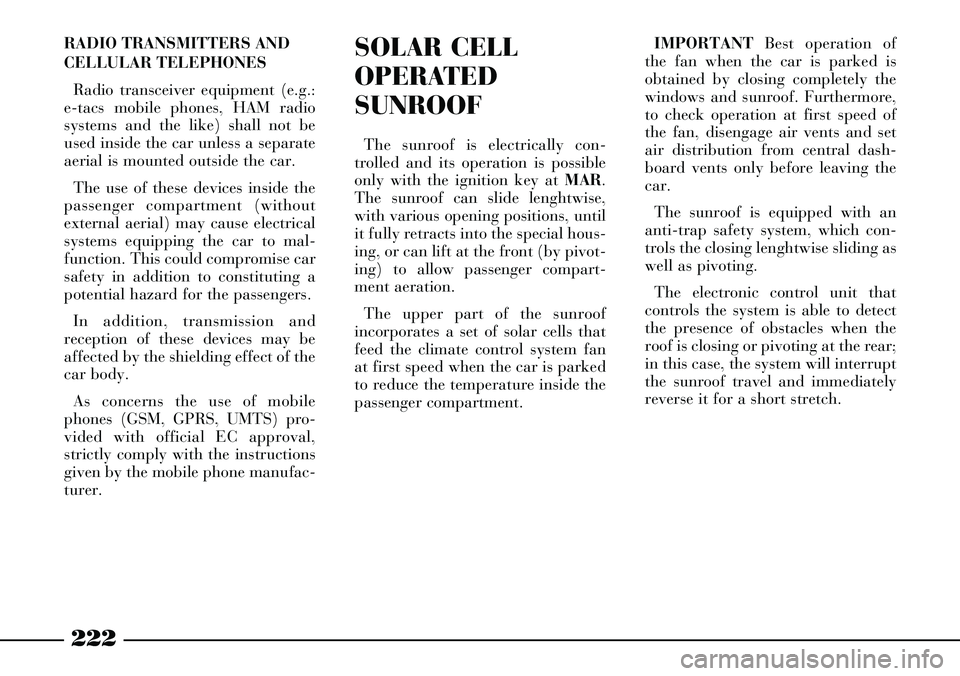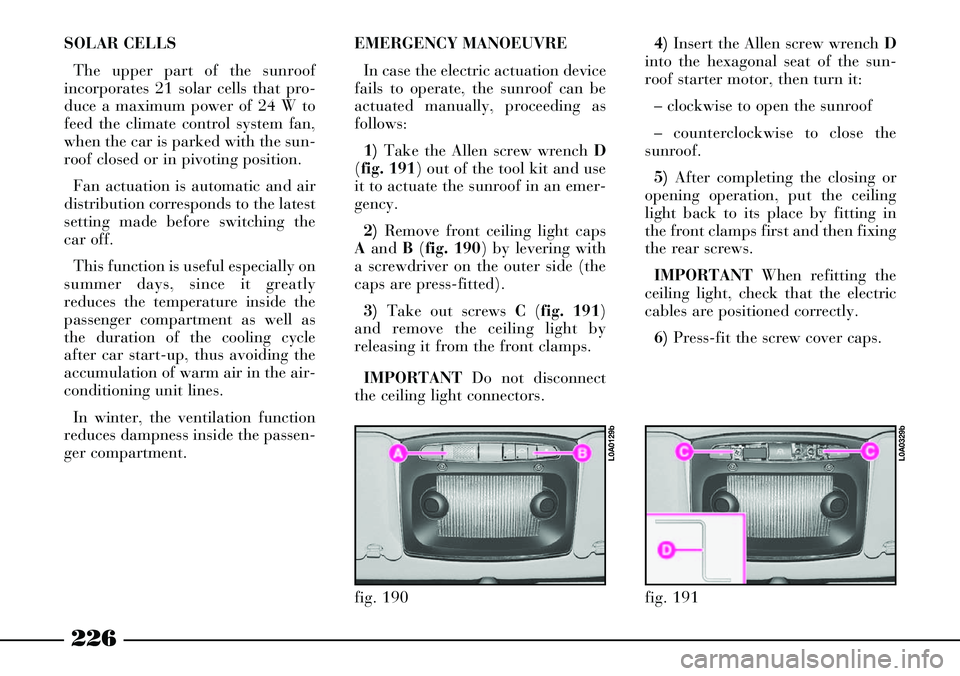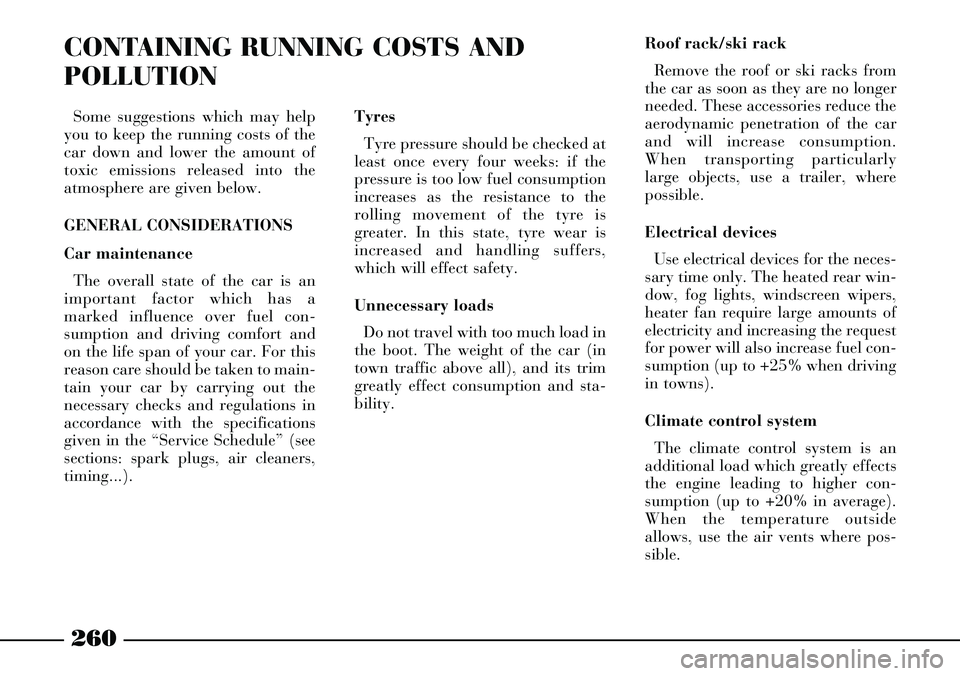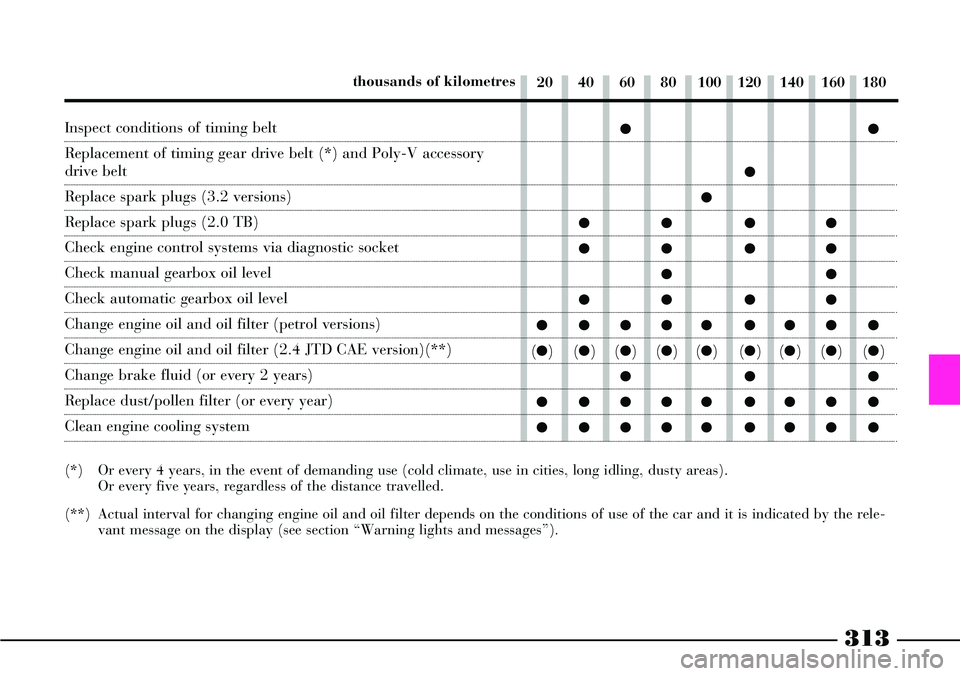climate control Lancia Thesis 2006 Owner handbook (in English)
[x] Cancel search | Manufacturer: LANCIA, Model Year: 2006, Model line: Thesis, Model: Lancia Thesis 2006Pages: 386, PDF Size: 8.69 MB
Page 220 of 386

219
REAR BOTTLE/CAN HOLDER
(fig. 178)
Bottle/can holder Ais incorporated
in the rear armrest.
To open it, press on the point spec-
ified by the arrow, then release it:
the bottle/can holder will automati-
cally open.
To close the bottle/can holder,
push it into its seat.REAR ARMREST
COMPARTMENT
Inside the rear armrest is an odd-
ment compartment A(fig. 179), a
card holder Band a power socket C.
Depending on versions, the armrest
can also include:
– the control buttons for heating,
massage, lumbar adjustment and for
adaptation of rear side seats
– the button to shift the front pas-
senger’s seat
– the button to actuate the electric
window shades
fig. 178
L0A0073b
fig. 179
L0A0075b
fig. 177
L0A0252b
CENTRAL CONSOLE
COMPARTMENT (fig. 177)
Versions with automatic, two-zone
climate control system are provided
with an oddment compartment A,
placed on the rear part of the central
console.
Page 223 of 386

222
SOLAR CELL
OPERATED
SUNROOF
The sunroof is electrically con-
trolled and its operation is possible
only with the ignition key at MAR.
The sunroof can slide lenghtwise,
with various opening positions, until
it fully retracts into the special hous-
ing, or can lift at the front (by pivot-
ing) to allow passenger compart-
ment aeration.
The upper part of the sunroof
incorporates a set of solar cells that
feed the climate control system fan
at first speed when the car is parked
to reduce the temperature inside the
passenger compartment.IMPORTANTBest operation of
the fan when the car is parked is
obtained by closing completely the
windows and sunroof. Furthermore,
to check operation at first speed of
the fan, disengage air vents and set
air distribution from central dash-
board vents only before leaving the
car.
The sunroof is equipped with an
anti-trap safety system, which con-
trols the closing lenghtwise sliding as
well as pivoting.
The electronic control unit that
controls the system is able to detect
the presence of obstacles when the
roof is closing or pivoting at the rear;
in this case, the system will interrupt
the sunroof travel and immediately
reverse it for a short stretch. RADIO TRANSMITTERS AND
CELLULAR TELEPHONES
Radio transceiver equipment (e.g.:
e-tacs mobile phones, HAM radio
systems and the like) shall not be
used inside the car unless a separate
aerial is mounted outside the car.
The use of these devices inside the
passenger compartment (without
external aerial) may cause electrical
systems equipping the car to mal-
function. This could compromise car
safety in addition to constituting a
potential hazard for the passengers.
In addition, transmission and
reception of these devices may be
affected by the shielding effect of the
car body.
As concerns the use of mobile
phones (GSM, GPRS, UMTS) pro-
vided with official EC approval,
strictly comply with the instructions
given by the mobile phone manufac-
turer.
Page 227 of 386

226
SOLAR CELLS
The upper part of the sunroof
incorporates 21 solar cells that pro-
duce a maximum power of 24 W to
feed the climate control system fan,
when the car is parked with the sun-
roof closed or in pivoting position.
Fan actuation is automatic and air
distribution corresponds to the latest
setting made before switching the
car off.
This function is useful especially on
summer days, since it greatly
reduces the temperature inside the
passenger compartment as well as
the duration of the cooling cycle
after car start-up, thus avoiding the
accumulation of warm air in the air-
conditioning unit lines.
In winter, the ventilation function
reduces dampness inside the passen-
ger compartment.EMERGENCY MANOEUVRE
In case the electric actuation device
fails to operate, the sunroof can be
actuated manually, proceeding as
follows:
1)Take the Allen screw wrench D
(fig. 191) out of the tool kit and use
it to actuate the sunroof in an emer-
gency.
2)Remove front ceiling light caps
Aand B(fig. 190) by levering with
a screwdriver on the outer side (the
caps are press-fitted).
3)Take out screws C(fig. 191)
and remove the ceiling light by
releasing it from the front clamps.
IMPORTANTDo not disconnect
the ceiling light connectors.4)Insert the Allen screw wrench D
into the hexagonal seat of the sun-
roof starter motor, then turn it:
– clockwise to open the sunroof
– counterclockwise to close the
sunroof.
5)After completing the closing or
opening operation, put the ceiling
light back to its place by fitting in
the front clamps first and then fixing
the rear screws.
IMPORTANTWhen refitting the
ceiling light, check that the electric
cables are positioned correctly.
6)Press-fit the screw cover caps.
fig. 190
L0A0129b
fig. 191
L0A0329b
Page 253 of 386

252
IMPORTANTEnergy-absorbing
devices (climate control system,
heated rear window etc.) are auto-
matically disconnected at starting.
If the engine does not start at the
first attempt, return the ignition key
to STOPbefore trying to start the
engine again.
If starting is particularly diffi-
cult,(with the Lancia CODE system
working properly) do not keep try-
ing too many times.
Use an auxiliary battery only if the
battery has insufficient charge.
Never use a battery charger to start
the engine. ENGINE WARMING UP
– Begin to move forward slowly let-
ting the engine turn at medium revs.
Do not accelerate abruptly.
– Do not push the engine to its limit
for the first few kilometers. You are
recommended to wait until the
coolant temperature has reached 50
to 60 °C.STOPPING THE ENGINE
– Release the accelerator pedal and
wait until the engine is idling.
– Turn the ignition key to STOP
and turn the engine off. For versions
with electronic automatic gearbox,
put the selector to Pbefore turning
the engine off.
IMPORTANTAfter a taxing drive
you should allow the engine to
“catch its breath” before turning it
off by letting it idle to allow the tem-
perature in the engine compartment
to fall.
Page 261 of 386

260
CONTAINING RUNNING COSTS AND
POLLUTION
Some suggestions which may help
you to keep the running costs of the
car down and lower the amount of
toxic emissions released into the
atmosphere are given below.
GENERAL CONSIDERATIONS
Car maintenance
The overall state of the car is an
important factor which has a
marked influence over fuel con-
sumption and driving comfort and
on the life span of your car. For this
reason care should be taken to main-
tain your car by carrying out the
necessary checks and regulations in
accordance with the specifications
given in the “Service Schedule” (see
sections: spark plugs, air cleaners,
timing...).Tyres
Tyre pressure should be checked at
least once every four weeks: if the
pressure is too low fuel consumption
increases as the resistance to the
rolling movement of the tyre is
greater. In this state, tyre wear is
increased and handling suffers,
which will effect safety.
Unnecessary loads
Do not travel with too much load in
the boot. The weight of the car (in
town traffic above all), and its trim
greatly effect consumption and sta-
bility.Roof rack/ski rack
Remove the roof or ski racks from
the car as soon as they are no longer
needed. These accessories reduce the
aerodynamic penetration of the car
and will increase consumption.
When transporting particularly
large objects, use a trailer, where
possible.
Electrical devices
Use electrical devices for the neces-
sary time only. The heated rear win-
dow, fog lights, windscreen wipers,
heater fan require large amounts of
electricity and increasing the request
for power will also increase fuel con-
sumption (up to +25% when driving
in towns).
Climate control system
The climate control system is an
additional load which greatly effects
the engine leading to higher con-
sumption (up to +20% in average).
When the temperature outside
allows, use the air vents where pos-
sible.
Page 299 of 386

298
Devices and utilities
Horn
Windscreen wiper controls
Brake light control (NC)
Brake light control (NA)
Ignition switch
Air conditioner compressor
Cruise Control (satellite controls)
Cruise Control (Adaptive point)
Climate control system fan
Engine cooling electric fan (first)
Engine cooling electric fan (second)
Right-hand headlight (control unit)
Left-hand headlight (control unit)
Diesel fuel filter (PTC)
Electronic injection system
Injectors (diesel versions)
Driving position point interface
Automatic transmission point interface
Climate control system point interface
Fuse
11
23
20
14
7
12
20
20
5
3
4
10
10
16
13
19
14
15
23
6
15
Ampere
15
7.5
7.5
10
20
7.5
7.5
7.5
40
60
20
7.5
7.5
20
7.5
20
20
10
7.5
10
7.5
Location
fig. 75
fig. 73
fig. 73
fig. 73
fig. 75
fig. 75
fig. 73
fig. 73
fig. 75
fig. 75
fig. 78
fig. 78
fig. 78
fig. 75
fig. 75
fig. 75
fig. 78
fig. 78
fig. 73
fig. 73
fig. 73
Page 314 of 386

313
Inspect conditions of timing belt
Replacement of timing gear drive belt (*) and Poly-V accessory
drive belt
Replace spark plugs (3.2 versions)
Replace spark plugs (2.0 TB)
Check engine control systems via diagnostic socket
Check manual gearbox oil level
Check automatic gearbox oil level
Change engine oil and oil filter (petrol versions)
Change engine oil and oil filter (2.4 JTD CAE version)(**)
Change brake fluid (or every 2 years)
Replace dust/pollen filter (or every year)
Clean engine cooling system
(*) Or every 4 years, in the event of demanding use (cold climate, use in cities, long idling, dusty areas).
Or every five years, regardless of the distance travelled.
(**) Actual interval for changing engine oil and oil filter depends on the conditions of use of the car and it is indicated by the rele-
vant message on the display (see section “Warning lights and messages”).20 40 60 80 100 120 140 160 180 thousands of kilometres
çç
ç
ç
çç çç
çç çç
çç
çç çç
ççççç çççç
(ç)(ç)(ç)(ç)(ç)(ç)(ç)(ç)(ç)
ççç
ççççç çççç
ççççç çççç
Page 327 of 386

326
Batteries contain sub-
stances that are very
harmful for the environ-
ment. You are advised to have the
battery changed at a Lancia
Dealership. It is properly
equipped for disposing of used
batteries in an environmentally-
friendly way that complies with
the law.
With the battery flat, or
after the interruption of
one of the protection
fuses, or if you want to disconnect
a loaded battery (e.g. for a car
stop period), before opening the
luggage compartment bonnet
carefully read and comply with
the instructions contained in the
paragraph “If battery is to be dis-
connected” in the chapter “In an
emergency”.
DUST/POLLEN
FILTER
This filter has a mechanical/elec-
trostatic air filtering action, provid-
ed that windows and doors are
closed.
Have the dust/pollen filter checked
once a year at a Lancia Dealership,
preferably at the onset of summer.
If the car is often used in dusty or
extremely polluted environments,
have the filter replaced more fre-
quently than specified in the Service
Schedule.
IMPORTANTFailure to replace
this filter can significantly reduce
climate control system effectiveness.
BATTERY
The battery is of the “Low
Maintenance” type and is fitted with
an indicator A(fig. 18) for checking
the electrolyte level and battery
charge.
Under normal condition of use top-
ping up the electrolyte with distilled
water is therefore not required. A
periodical check is however neces-
sary to make sure it is in efficient
conditions through the indicator on
the battery cover which should be
dark in colour with a green central
area.If the indicator is a bright colour,
or dark without the green central
area, contact a Lancia Dealership.
fig. 18
L0A0164b
Page 336 of 386

335
HEADLIGHT
WASHERS
Regularly check that the nozzles
(fig. 22) are intact and clean.
The headlight washers are auto-
matically switched on when the
windscreen washer is operated and
the headlights are on.
CLIMATE
CONTROL SYSTEM
During the winter, the climate con-
trol system must be turned on at
least once a month for about ten
minutes.
Before summer, have the system
checked at a Lancia Dealership.INITIALISING THE AIR
CONDITIONING CONTROL UNIT
Whenever the battery is electrically
connected again or it is reloaded after
being completely flat or after replac-
ing one of the protection fuses, to re-
store the correct operation of the air
conditioning, of the door locking and
of the ESP system. It is necessary to
perform the initialisation operations
contained in the paragraph “If battery
is to be disconnected” in the chapter
“In an emergency”.
fig. 22
L0A0122b
The system is filled with
R134a refrigerant which
will not pollute the envi-
ronment in the event of leakage.
Under no circumstances should
R12 fluid be used as it is incom-
patible with the system compo-
nents and contains CFC.
Page 367 of 386

366
FUEL
CONSUMPTION
The fuel consumption values
shown in the following table were
defined according to the type-
approval specifications in European
Directives.
Consumption values are defined by
means of the following procedures:– urban cycle: consisting of a cold
start and a simulated drive in city
streets;
– extra-urban cycle: consisting in
frequent accelerations, in all gears,
simulating normal conditions of use.
Speed ranges from 0 to 120 km/h;
– combined consumption: con-
sisting of 37% urban cycle and 63%
extra-urban cycle.IMPORTANTRoad and traffic
conditions, weather, general condi-
tions of the car, driving style, fittings
and accessories, use of the climate
control system, load, roof racks and
other situations penalising aerody-
namic penetration and effecting
rolling resistance will influence fuel
consumption rates which can be dif-
ferent from the values shown in the
table (see “Cheap running that
respects the environment” in
“Driving your car” chapter).
2.4
15.2
8.4
10.9 2.0 TB
15.5
8.5
11.12.4 CAE
17.4
8.8
12.02.4 JTD 20V CAE
12.1
6.9
8.83.2 V6 CAE
22.7
10.3
14.9Consumption according
to Directive
1999/100/CE(litres x 100 km)
Urban
Extra-urban
Average combined